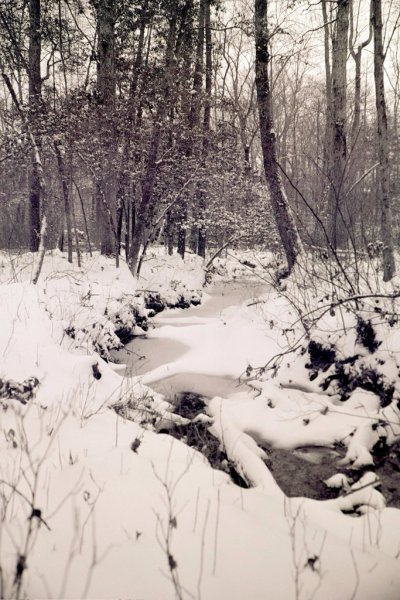
Streams with tree-lined banks are two to eight times more capable of processing nutrients and organic matter than streams without a healthy fringe of trees. That’s what scientists at the Stroud Water Research Center in Pennsylvania tell us. It doesn’t matter if that organic matter comes from a sewage treatment plant or the back end of a cow.
Why? Streams flowing through woods have a thriving aquatic ecosystem full of microbes and insects that consume nutrients and organic matter. Forested streamsides, at least in the temperate Eastern United States, are a necessary component of healthy riverine systems.
More than 90 percent of the stream miles in the United States are headwater streams. These are “zero order” to “third order” streams: the ones that just bubble out of the ground to those that have no more than six tributaries entering upstream of them. Most of them don’t even have names.
These countless small streams have a huge impact on the health of our rivers and estuaries like the Chesapeake Bay, the Albemarle Sound and the Gulf of Mexico. In order to have healthy rivers in the temperate Eastern United States, it is imperative that most of these headwater streams have trees along their banks.
A streamside forest of native trees provides many important ecosystem services. Some are obvious, like stabilizing the stream banks, filtering out nutrients, providing shade and sequestering carbon. But trees do much more.
Native deciduous trees provide headwater streams with a lot of the food that aquatic microbes and insects such as mayflies, caddisflies and stoneflies need for a thriving ecosystem. The hard work of all of these creatures make a stream capable of processing two to eight times more pollutants than a stream flowing through non-forested lands.
There are hundreds of species of aquatic insects that eat leaves; entomologists call them “shredders”. Likewise there are many species of trees. The leaves from different trees have different nutritional values and each insect species prefers certain species over others and often grows best on the tree that it prefers. One species of caddisfly, for example, prefers tulip poplar leaves to river birch leaves. One species of mayfly prefers American sycamore leaves to white oak leaves.
To support a diverse community of aquatic insects, we need a diverse community of native trees to provide them with the food they need to help them do their work in processing material that enters the stream.
Leaves from non-native plants won’t do. Scientists at the Stroud Water Research Center found no “shredder” that would eat the leaves of multiflora Rose. Sycamore, black willow, catalpa and tulip poplar are more palatable and far superior at supplying food than tree of heaven, Bradford pear and multiflora rose, all of which are invasive, and nonnative.
Trees also help to cool water temperatures in streams during the summer. Cool summer temperatures are more natural and critical to a thriving aquatic ecosystem. Some native mayflies, for example, thrive at 68 degrees but perish at 70.
Trees do more. Sunlight intensity reaching the stream affects the type of algae that grow in the water. Direct sunlight favors long filamentous types of algae that are not desirable food for insects. The light levels beneath a tree canopy are ideal for single-celled algae, called diatoms, which are the preferred food of insects. These types of algae can also coat the surfaces of leaves, making them more palatable and nutritious to “shredder insects.”
Many efforts are under way to improve our streams through reforestation. Farmers in the Chesapeake Bay watershed, for example, have excluded livestock from more than 7,000 miles of streams and planted more than 6.5 million hardwood trees to form forested buffers for streams through U.S. Department of Agriculture’s Conservation Reserve Enhancement Program. A restored Chesapeake Bay is within our reach through these kinds of efforts.
These farmers deserve our thanks and our support. We should encourage the continuation of programs that help them keep livestock out of streams, plant trees that trap sediment and nutrients and help detoxify polluted runoff containing pathogens and hormones that would otherwise end up in our water.
These leafy banks also help our streams become thriving aquatic ecosystems that support native trout, as well as a healthy, diverse aquatic community.
Robert Whitescarver, President, Whitescarver Natural Resources Management LLC, is a retired NRCS District Conservationist and CREP Technical Coordinator for Virginia. Reach him at bobby.whitescarver [at] gettingmoreontheground.com. Distributed by Bay Journal News Service.


